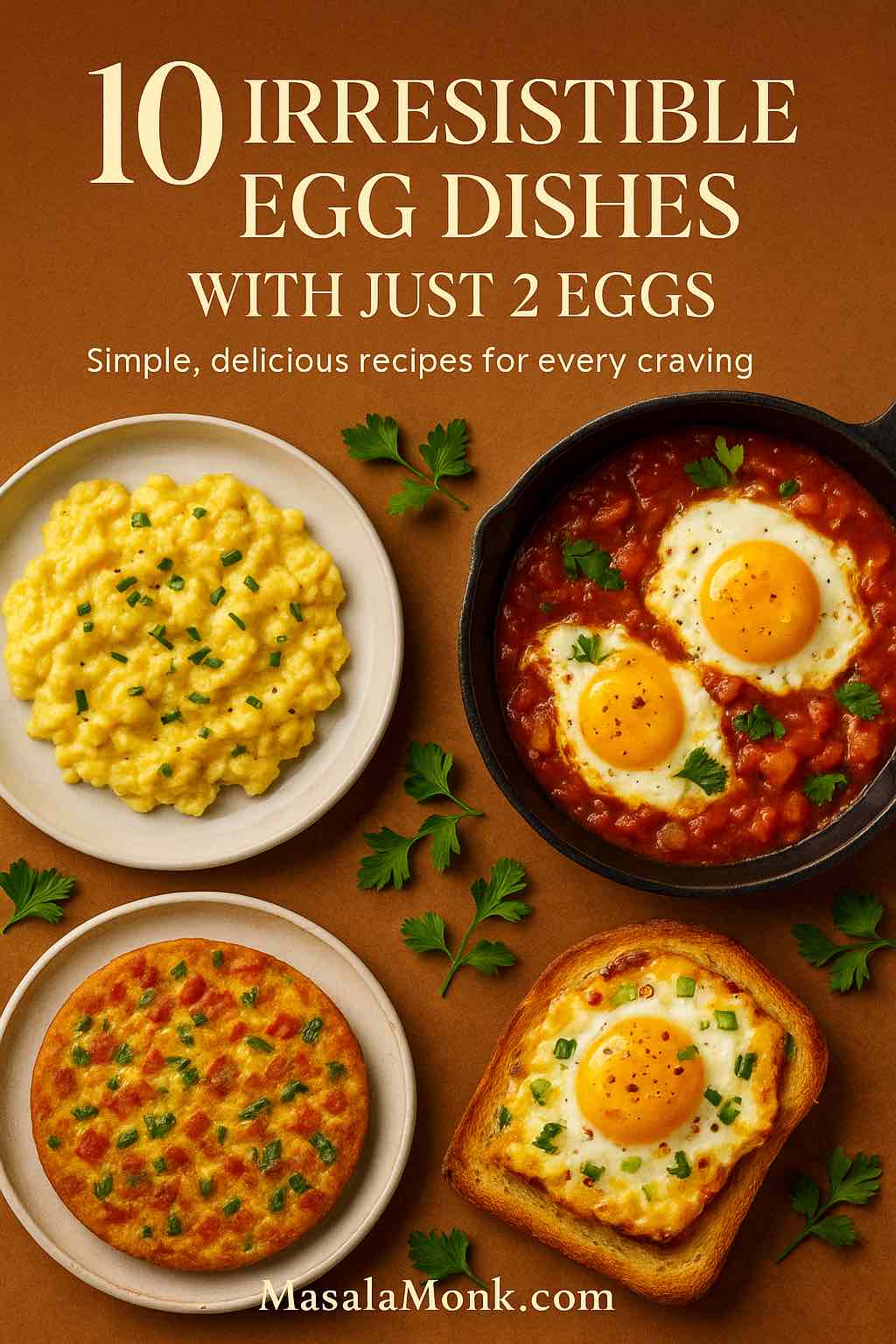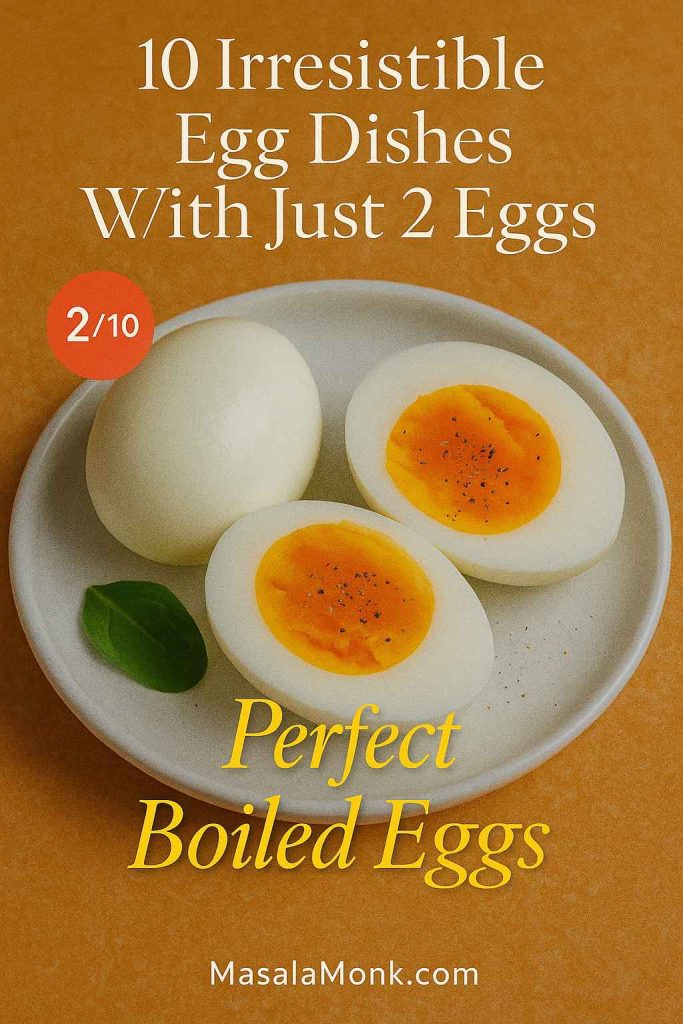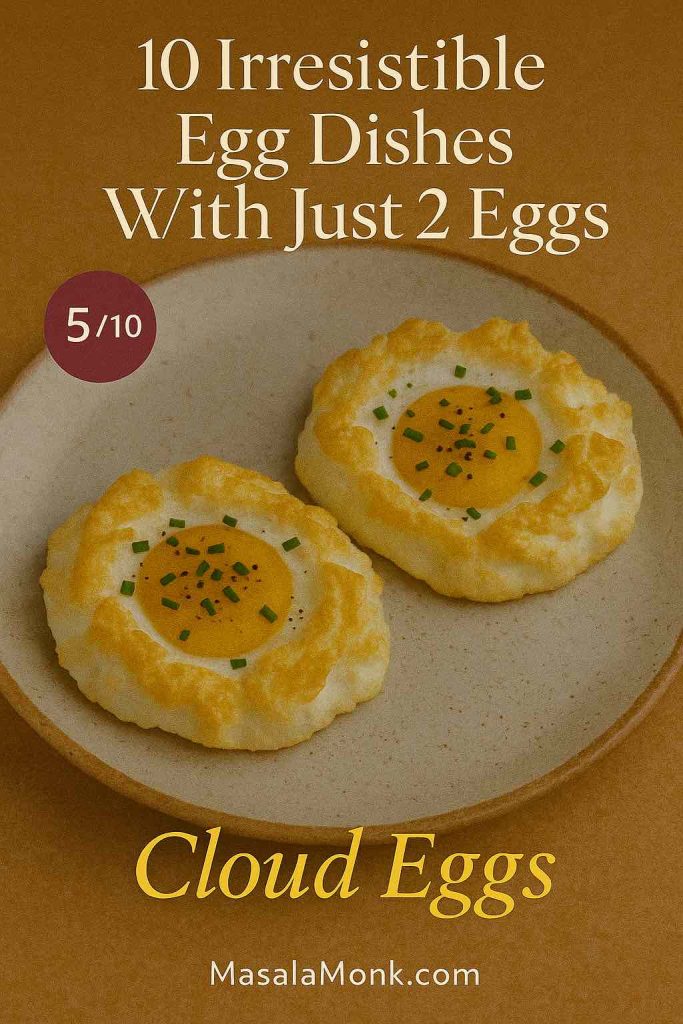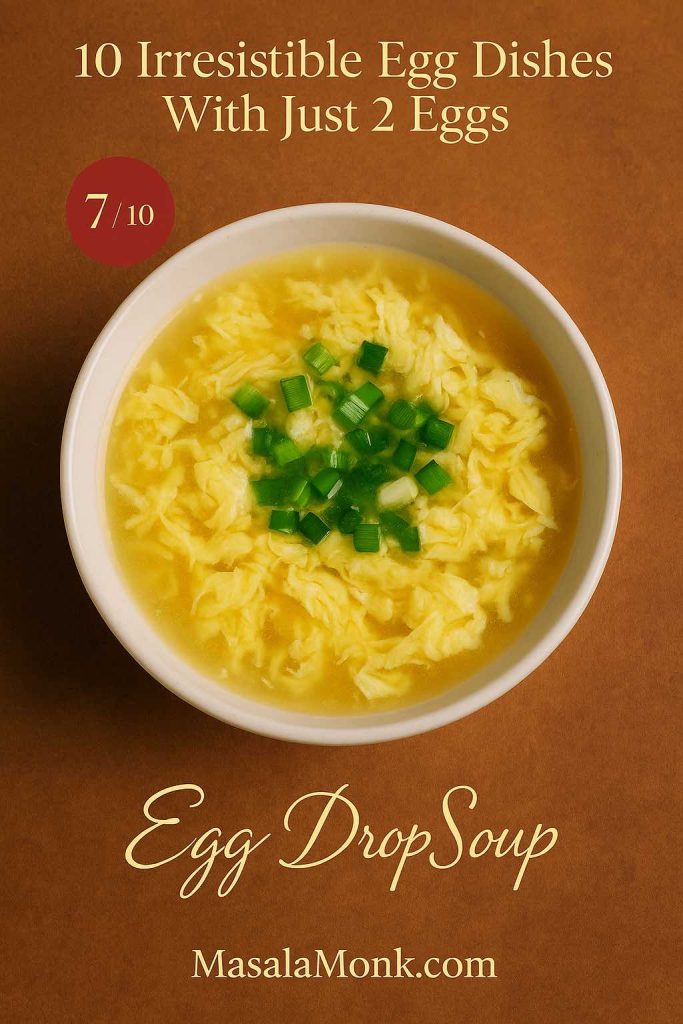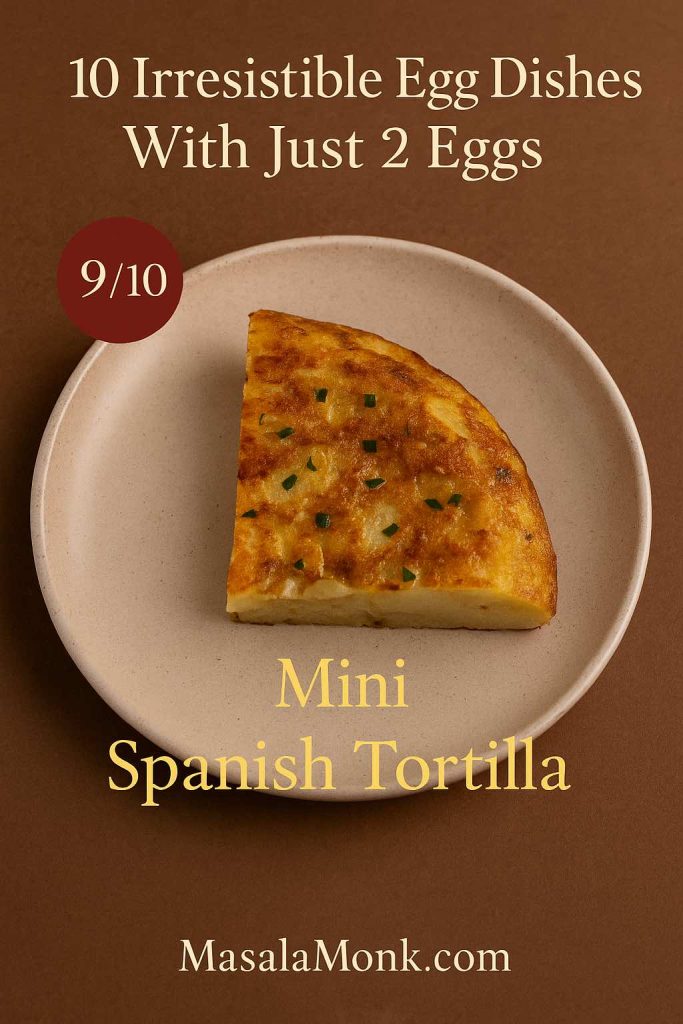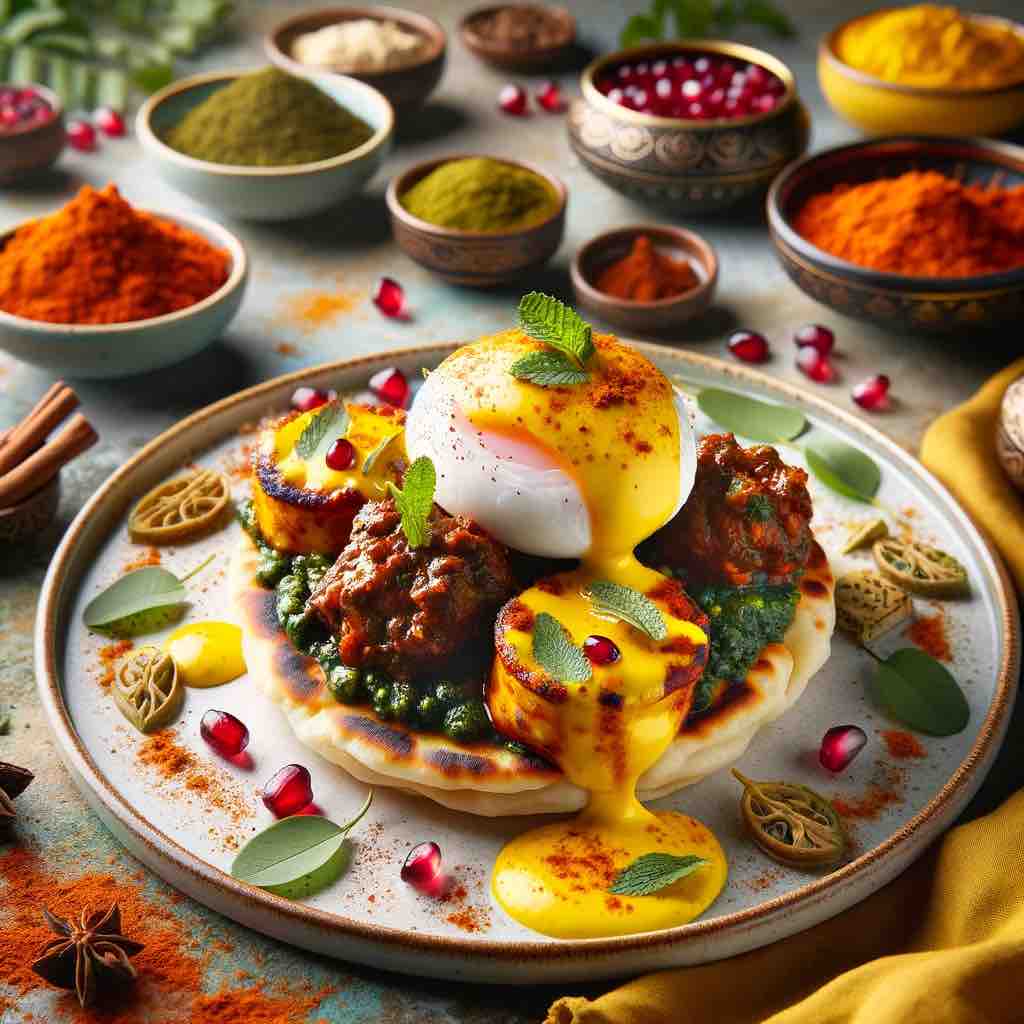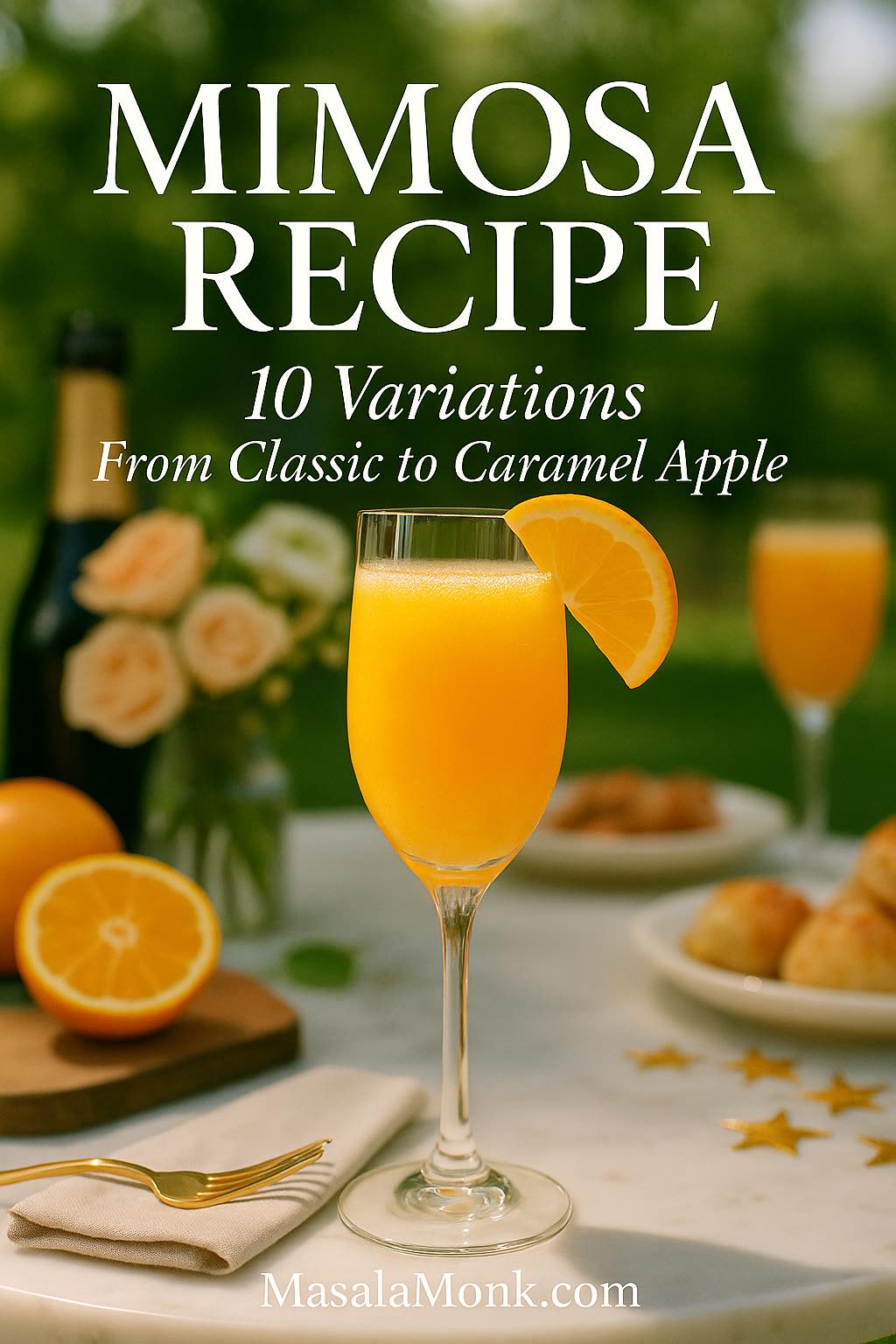
There are very few drinks that say “slow, happy morning” as clearly as a glass of mimosa. It looks sunny, tastes bright, and somehow makes even a regular Sunday feel like a small celebration. At the same time, a good mimosa recipe is almost ridiculously simple: chilled sparkling wine, chilled juice, and a moment’s care when you pour.
Yet once you start playing with that basic formula, things get interesting fast. A splash of orange liqueur suddenly turns your drink into something restaurant-worthy. A bit of pineapple or strawberry purée sends it straight to the tropics. Apple cider and caramel transform it into a cosy fall treat. In other words, there isn’t just one mimosa recipe—there are dozens, and most of them are only a tiny tweak away from the classic.
Before we jump into all the fun twists, it’s worth grounding ourselves in what a mimosa actually is and where it came from. That way, every variation feels like part of a story rather than just a random splash of juice.
What Is a Mimosa?
At its core, a mimosa is a simple mixed drink made with sparkling wine and orange juice, usually served in a champagne flute. Most sources agree that it’s closely related to the Buck’s Fizz, a drink created in the 1920s at Buck’s Club in London. The Buck’s Fizz tends to use more Champagne and less juice, whereas the mimosa often leans toward equal parts. Over the years, the mimosa has become tightly linked with brunch, weddings, and leisurely daytime events.
Consequently, the mimosa picked up a reputation as the “acceptable” morning drink. Because the orange juice feels familiar and breakfast-y, the bubbles don’t come across as heavy or “too much.” This combination of freshness and festivity is why the mimosa recipe remains such a favourite.
However, there’s nothing in the original idea that says the juice must be orange, or that you can’t add a small splash of something extra. Once you accept that, a whole world of variations opens up. Still, everything begins with one foundational drink.
Also Read: 10 Best Chicken Sandwich Recipes (BBQ, Parm, Buffalo & More)
Classic Mimosa Recipe (Champagne and Orange Juice)
Think of this as the blueprint. Once you can make this with your eyes half-closed, every other version will feel easy and natural.
Ingredients (Per Glass)
- 2 ounces (60 ml) chilled orange juice
- Freshly squeezed is wonderful; good-quality not-from-concentrate works too.
- 4 ounces (120 ml) chilled dry sparkling wine
- Brut Champagne, cava, or prosecco are all excellent choices.
- 1 thin orange slice or twist, to garnish (optional)

Step-by-Step Method
- Chill everything thoroughly
First of all, get the temperature right. Pop the orange juice and sparkling wine into the fridge for several hours, or even overnight, so they’re properly cold. If you have room, you can even chill the glasses. A cold base means the bubbles last longer and the drink tastes much cleaner. - Pour the orange juice first
Next, pour the orange juice into the flute. Beginning with juice gives you more control and keeps the carbonation from going wild right away. - Top with sparkling wine
After that, tilt the glass slightly and pour the sparkling wine in a thin stream down the side. Many detailed guides, such as this classic mimosa recipe from Love & Lemons, recommend this order for exactly that reason—it preserves the delicate fizz. - Garnish and serve immediately
Finally, garnish with an orange slice or twist if you like, and serve right away. Mimosas aren’t meant to sit around; they’re brightest and most effervescent in the first 10–15 minutes.
What’s the Best Ratio for a Mimosa Recipe?
Although plenty of traditional recipes suggest a 1:1 ratio of orange juice to sparkling wine, modern tastes often drift toward a slightly drier drink. For that reason, a lot of bartenders and home hosts now prefer 1 part juice to 2 parts bubbly. It still tastes familiar and citrusy, yet it doesn’t feel heavy or overly sweet.
That said, the “best” ratio depends on your guests:
- Equal parts for people who like a juicier, softer drink
- 1:2 juice-to-wine for a crisper, more Champagne-forward profile
- Just a splash of juice in a tall glass of bubbles for those who mainly want sparkling wine with a hint of orange
You can even set up a small card at your brunch that suggests all three options, then let people choose their style.
Choosing Sparkling Wine for a Mimosa Recipe
Because you’re mixing the wine with juice, there’s no need to splurge. In fact, a number of tastings suggest that an affordable, well-made cava or similar sparkling wine beats expensive Champagne once you add orange juice. Pieces like the roundup on The Kitchn’s best Champagne for mimosas and the expert picks in Simply Recipes’ guide to sparkling wines for mimosas both lean toward dry, budget-friendly options.
As a rule of thumb:
- Look for “brut” or “extra dry” to balance the sweetness of the juice.
- Choose bottles with good acidity; they cut through the fruit and keep each sip refreshing.
- Save vintage Champagne for drinking on its own, where all those subtle flavours can shine.
Once you’re comfortable with this classic mimosa recipe, you’re ready to branch out into more playful territory.
Also Read: Chicken Alfredo Pasta, 5 Ways (Classic to Cajun, Veg, 15-Minute Jar, Healthy)
10 Easy Mimosa Recipe Variations from Classic to Caramel Apple
The beauty of a mimosa is that you can change its personality just by switching juices or adding a small splash of liqueur. Nevertheless, the basic technique stays the same, so you never have to relearn the whole process.
Below you’ll find ten versions that cover everything from summer pool days to winter holidays, from soft and fruity to stronger, cocktail-style flavours. You can serve them one at a time, or mix and match several as part of a mimosa bar.
1. Classic Mimosa Recipe for Laid-Back Weekends
The very first variation is the one you’ve already seen, yet it deserves a spot in the lineup. Sometimes you just want the original.
Per glass:
- 2 oz orange juice
- 4 oz dry sparkling wine
Pour the juice, then the wine, garnish, and you’re done. You can make a whole tray of these to greet guests as they come in, and then move on to other mimosa recipe experiments once everyone’s settled.
If you’re planning a whole range of Champagne-style drinks, you might later enjoy stepping up to something slightly stronger and more sophisticated, such as the French 75 cocktail recipe on MasalaMonk, which blends gin, lemon, and bubbly in a beautifully balanced way.
2. Grand Marnier Mimosa Recipe (Grand Mimosa)
Now let’s upgrade that simple base. By adding a little orange liqueur, you create a “grand” mimosa that feels like it belongs on a hotel brunch menu.
Ingredients (per glass):
- 2 oz orange juice
- ½–1 oz Grand Marnier or Cointreau
- 3–4 oz dry sparkling wine
- Orange twist, to garnish

How to build it:
- Start by pouring orange juice into your glass.
- Then add Grand Marnier. If you’d like more warmth and depth, go closer to 1 ounce; for a gentler effect, ½ ounce is plenty.
- Next, pour in the sparkling wine, slowly and at an angle.
- Finally, garnish with a twist of orange peel.
Because Grand Marnier brings both orange and a subtle cognac base, this mimosa recipe feels richer and more layered than the original. On the other hand, if you prefer a cleaner citrus profile, you might swap Grand Marnier for Cointreau. Either way, this is an effortless way to impress guests without making your life harder.
Also Read: Béchamel Sauce for Lasagna: Classic, Vegan & Ricotta Sauce Recipe
3. Vodka Mimosa Recipe (Playful Manmosa)
Occasionally, the table wants something a little stronger. That’s where a vodka mimosa recipe comes in. It’s still bubbly and citrusy, yet it carries more of a cocktail-style punch.
You’ll need:
- 2 oz orange juice
- 1 oz vodka
- 3–4 oz sparkling wine

Method:
- Pour orange juice and vodka into the flute.
- Stir briefly to blend the vodka into the juice.
- Top with sparkling wine and serve at once.
Some people call this a “manmosa,” although the name is more joke than rule. It’s simply a bright, easy-drinking cocktail with added backbone from the vodka. If you have guests who enjoy vodka-based drinks, you could, later on, direct them toward more complex options like the vodka with lemon cocktails or the mango vodka cocktail drinks on MasalaMonk for after-brunch sipping.
4. Pineapple Mimosa Recipe with Malibu Option
As soon as the weather warms up, a pineapple mimosa recipe feels almost essential. It’s juicy, sunny, and incredibly refreshing.
Classic Pineapple Mimosa
Per glass:
- 2 oz pineapple juice
- 4 oz prosecco or cava
- Pineapple wedge or lime wheel, for garnish
Pour the pineapple juice, then add the sparkling wine. A squeeze of lime over the top lifts the flavour beautifully.

Pineapple Mimosa with Malibu
For a more tropical twist, add a bit of coconut rum:
- 2 oz pineapple juice
- 1 oz Malibu or another coconut rum
- 3 oz sparkling wine
Mix the juice and Malibu first, then top with bubbly and garnish with pineapple. Suddenly, your mimosa recipe tastes like a tiny vacation in a glass.

If you’d like to build a full tropical-themed drinks menu, you can easily combine these pineapple mimosas with coconut water cocktails and some playful piña colada variations as the day goes on.
5. Cranberry Mimosa Recipe (Holiday Pink Mimosa)
When autumn and winter roll around, a cranberry mimosa recipe fits the mood perfectly. It’s tart, jewel-toned, and very festive.
Ingredients:
- 2 oz cranberry juice (100% juice if possible)
- 4 oz sparkling wine
- Optional: ¼ oz orange liqueur
- Fresh cranberries and orange slice, to garnish
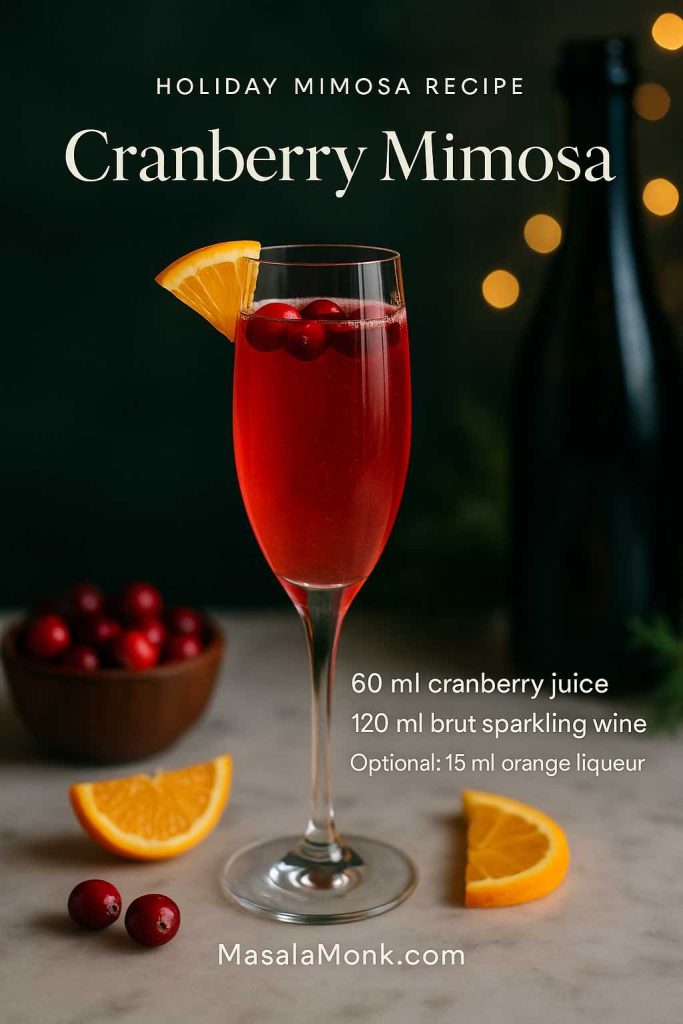
How to make it:
- Pour cranberry juice into the flute.
- Add the orange liqueur if you like a slightly richer profile.
- Top with sparkling wine.
- Drop a few cranberries into the glass and hang an orange slice on the rim.
Because of its colour, this mimosa recipe works beautifully for Christmas morning, holiday brunch, or even New Year’s Day. If you blend equal parts cranberry and orange juice instead, you’ll get a softer pink mimosa that still looks glamorous but tastes a bit less sharp.
Also Read: Natural Detoxification: Cranberry Juice and Apple Cider Vinegar for Weight Loss
6. Strawberry Mimosa Recipe (Plus Watermelon Twist)
Next, we turn to strawberries. A strawberry mimosa recipe feels romantic and celebratory—ideal for Mother’s Day, birthdays, or any spring gathering.
Strawberry Purée
To begin with, make a simple purée:
- 1 cup strawberries (fresh or thawed frozen)
- 1–2 tablespoons sugar or honey, to taste
- 1–2 teaspoons lemon juice
Blend everything until smooth. If you prefer a very silky drink, strain the mixture to remove seeds.
Strawberry Mimosa
Per glass:
- 1½–2 oz strawberry purée
- 3–4 oz sparkling wine
Spoon the purée into your glass, then add the sparkling wine carefully. If the purée is thick, you might stir once, gently, to combine.
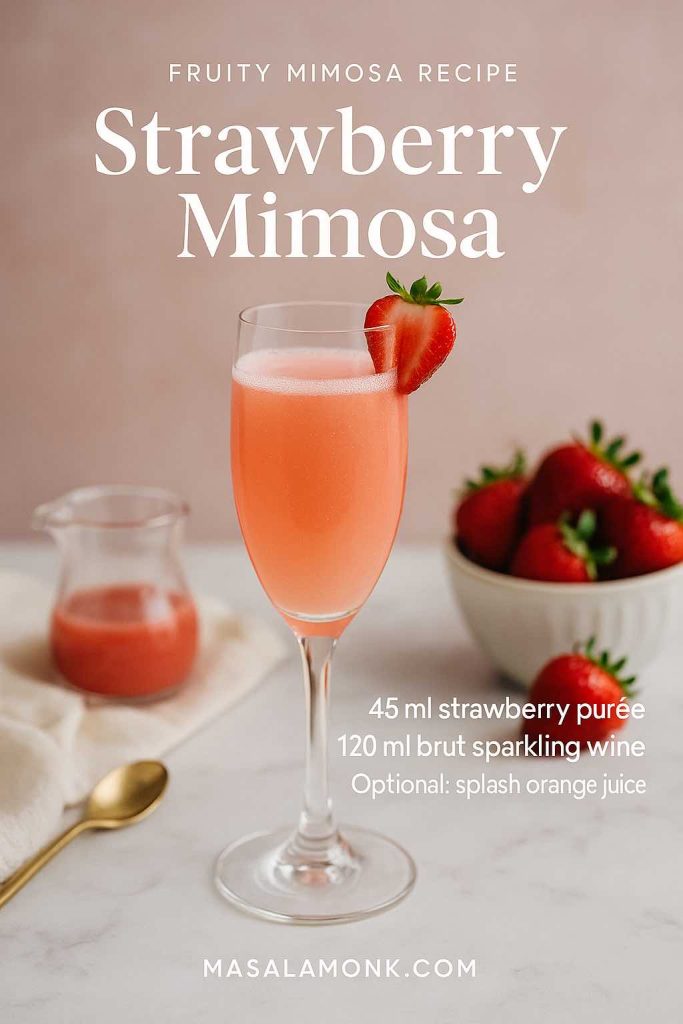
For extra brightness, feel free to add a small splash of orange juice or lemonade between the purée and the sparkling wine.
Watermelon Variation
If you’re craving something even more summery, you can adapt this mimosa recipe to watermelon. Simply blend cubes of seedless watermelon, strain the juice, and use that instead of the strawberry purée. A touch of lime juice makes the flavour pop.
Later on, if your guests fall in love with watermelon in their drinks, you can steer them toward a whole set of watermelon margarita variations for evening cocktails.
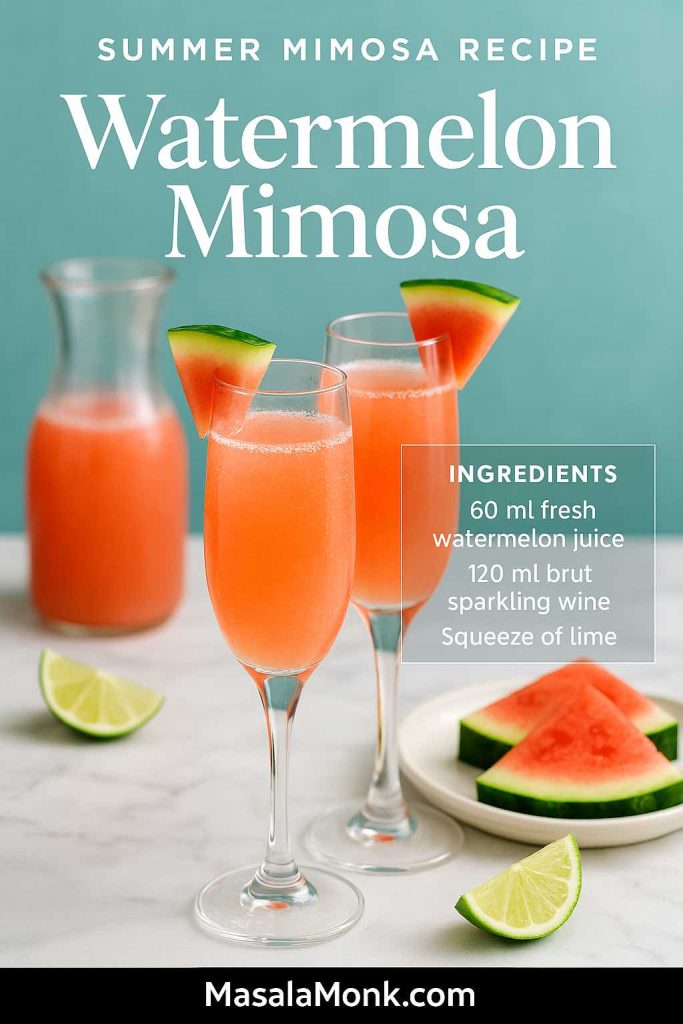
7. Peach Mimosa Recipe (Bellini-Style)
This peach mimosa recipe slides very close to the classic Bellini, and that’s exactly why people adore it. It’s soft, fragrant, and just a little decadent.
Ingredients:
- 2 oz peach nectar or peach purée
- 4 oz prosecco
- Peach slice, to garnish
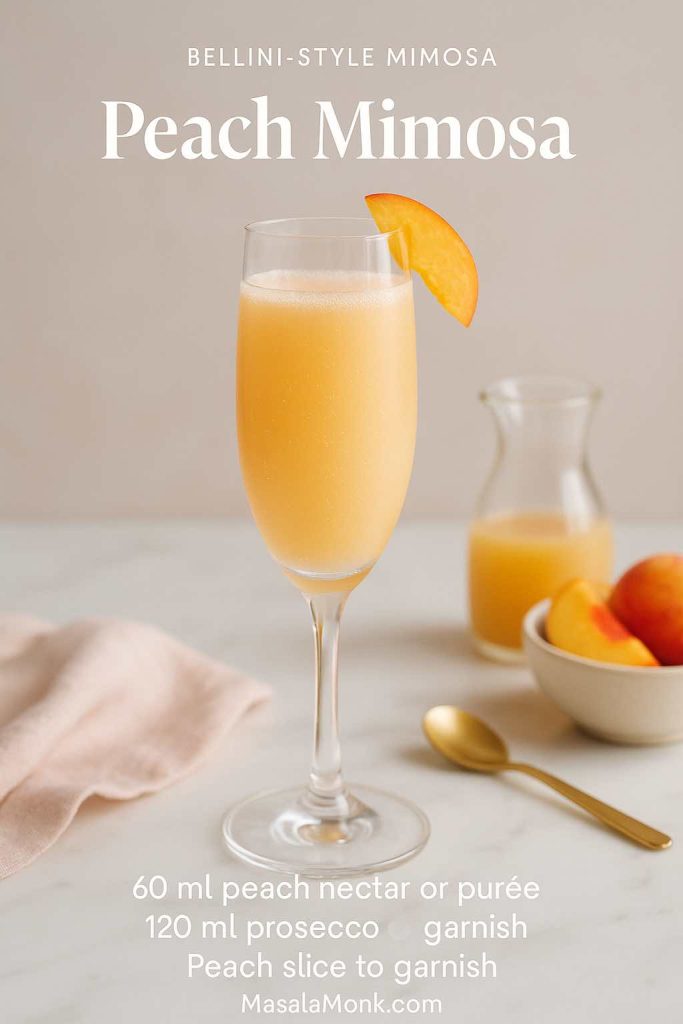
Instructions:
- Pour the peach nectar or purée into the flute.
- Top slowly with prosecco so it foams gently rather than exploding over the rim.
- Garnish with a thin peach slice.
Because it feels so elegant, this mimosa recipe is lovely for bridal showers, engagement brunches, or any gathering where you want something a bit special. It also pairs nicely with light desserts and fruit-forward sweets, especially something creamy like a tres leches cake.
8. Grapefruit Paloma Mimosa Recipe
If you enjoy a slightly bitter edge in your drinks, this grapefruit Paloma mimosa recipe will be right up your street. It’s bright, zesty, and just bold enough to wake everyone up.
Per glass:
- 2 oz pink grapefruit juice
- ½–1 oz blanco tequila (optional)
- 3 oz sparkling wine
- Salt or Tajín, for the rim
- Grapefruit wedge, to garnish
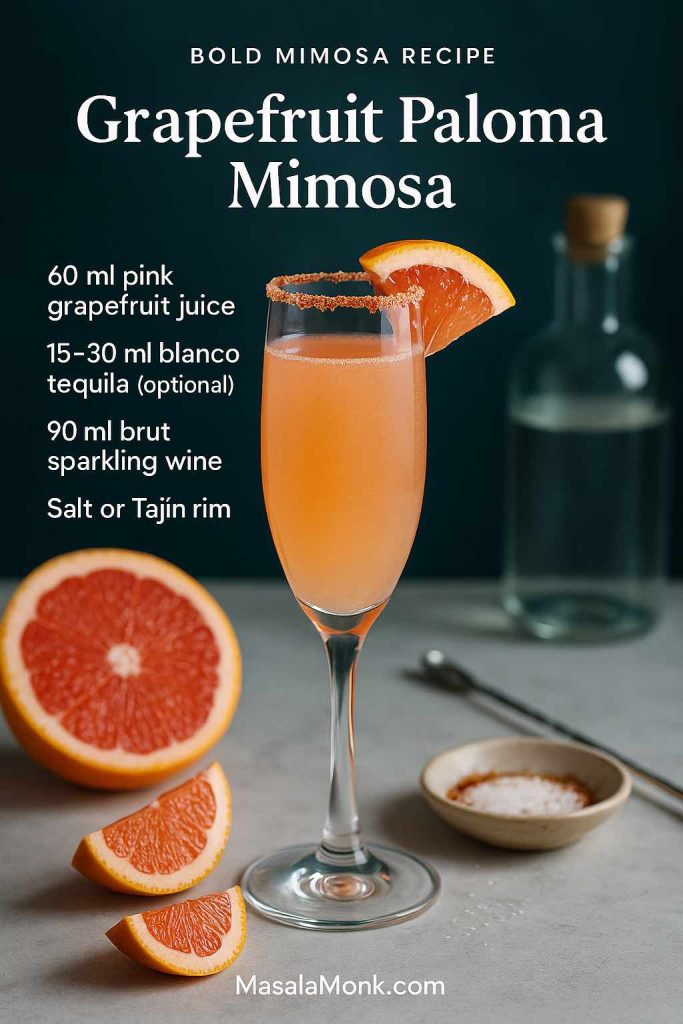
How to assemble:
- First, run a grapefruit wedge around the rim of the glass, then dip it in salt or Tajín.
- Next, pour grapefruit juice and tequila into the prepared flute.
- After that, top with sparkling wine.
- Finally, garnish with a small grapefruit wedge.
This mimosa recipe straddles the line between breakfast drink and cocktail, so it’s ideal for brunch that stretches into an afternoon filled with snacks and tacos. Later in the day, once people are in a more “cocktail hour” mood, you might bring out classics such as a Negroni recipe for those who love bitters.
9. Caramel Apple Cider Mimosa Recipe (Cozy Fall Favourite)
As soon as the air turns chilly, it’s time for a caramel apple mimosa recipe. It tastes like dessert but looks just as elegant as the classic.
Ingredients:
- Cinnamon sugar, for rimming the glass
- 2 oz chilled apple cider
- 1 oz caramel vodka
- 3 oz sparkling wine
- Thin apple slice, for garnish
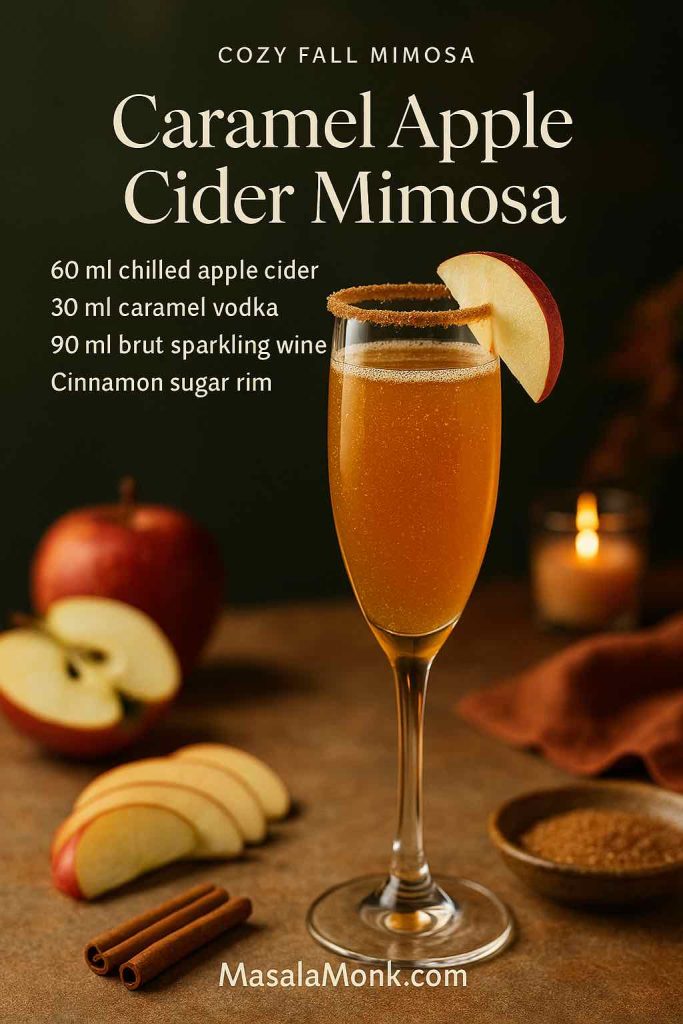
Method:
- Pour a little apple cider onto a plate and dip the rim of the glass in it. Then roll the rim in cinnamon sugar.
- Add the apple cider and caramel vodka to the glass.
- Top gently with sparkling wine.
- Add a thin apple slice as garnish.
If you’d like a lighter apple cider mimosa recipe, you can skip the vodka and simply enjoy the cider and bubbles with that fragrant cinnamon rim. Alongside this drink, you could serve dishes leaning into the same cosy mood: maybe something seasoned with homemade pumpkin pie spice, or a warm side like green bean casserole or crock pot lasagna soup.
10. Non-Alcoholic Mimosa Recipe (Sparkling Mock Mimosa)
Lastly, no mimosa collection feels complete without a non-alcoholic mimosa recipe. Everyone deserves a pretty, bubbly drink, whether they’re drinking alcohol or not.
Mock mimosa (per glass):
- 2 oz orange juice
- 2–3 oz sparkling water, club soda, or non-alcoholic sparkling wine
- Optional: splash of pineapple juice or white grape juice
- Orange slice, to garnish
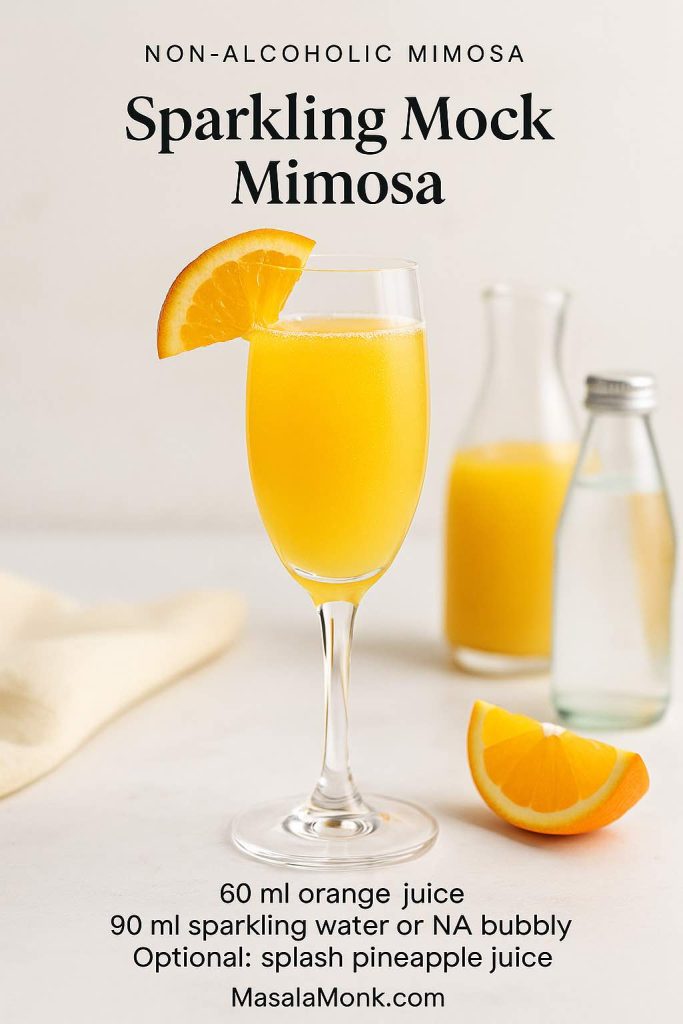
Instructions:
- Pour orange juice into the flute.
- Add the optional extra juice if you’d like more complexity.
- Top with sparkling water or alcohol-free bubbly.
- Garnish and serve.
Some mocktail versions use ginger ale and citrus-flavoured sparkling water, as in this mimosa mocktail idea, while others mix several juices and flavoured sparkling water, as in this non alcoholic mimosa version.
Meanwhile, if you’d like to round out your zero-proof options, you can add a margarita mocktail or a few keto mocktails to keep everyone happy all day.
How to Make Any Mimosa Recipe Taste Its Best
Although the recipes above give you plenty to play with, a few general habits will make every mimosa recipe you pour taste better, no matter which variation you choose.
Keep Everything Cold, Not Just the Wine
To begin with, treat the juice with as much respect as the bubbly. Store juices and purées in the coldest part of the fridge, and don’t leave them on the counter too long while you set up. Cold ingredients:
- Preserve the fizz in the sparkling wine
- Keep flavours bright and refreshing
- Make each mimosa recipe feel more polished and intentional
If you can, chill the glassware too. Even a quick 20 minutes in the fridge or freezer helps.
Use the Right Order and Gentle Pours
Furthermore, the sequence in which you pour makes a noticeable difference. Juice goes in first, then any spirit or liqueur, then sparkling wine. This order:
- Stops the fizz from erupting and overflowing
- Makes it easier to estimate your ratio
- Keeps the drink visually neat
Moreover, always pour the sparkling wine slowly and at an angle. You’re not just filling a glass; you’re preserving bubbles.
Choose Good, Not Fancy, Sparkling Wine
As mentioned earlier, there’s broad agreement that you don’t need expensive bottles for a mimosa recipe. Guides such as the mimosa-focused tasting on The Kitchn and expert opinions on Simply Recipes consistently favour dry, affordable options.
Therefore, you can happily:
- Reach for cava, a dry prosecco, or any well-made brut sparkling wine
- Keep a couple of different bottles on hand for variety
- Save the top-shelf Champagne for sipping later in the day
Add Spirits Sparingly
Because it’s tempting to think “more is more,” it’s easy to overdo vodka, bourbon, or tequila. However, the charm of a mimosa recipe lies in its gentle nature. For that reason:
- ½ ounce of spirit is enough for a subtle twist
- 1 ounce is plenty for a stronger brunch cocktail
- Anything beyond that risks turning the drink into something harsh and unbalanced
Think of the spirit as seasoning—just a touch to shift the mood, not the main feature.
Also Read: How to Cook Perfect Rice Every Time (Recipe)
Building a Mimosa Bar Around Your Favourite Mimosa Recipe
Once you’ve tried a few variations, you might feel inspired to put it all together into a full mimosa bar. That way, guests can customise their own drinks, and you can relax and enjoy your own glass.
Step 1: Arrange the Juices
Start with a few chilled carafes or jugs. At minimum, you might offer:
- Orange juice
- Pineapple juice
- Cranberry juice
In addition, if you’d like more variety, you can add:
- Pink grapefruit juice
- Peach nectar
- Apple cider (especially in autumn)
- Strawberry or watermelon purée in small bottles or jugs
Label each one clearly so people know what they’re choosing. You can also add a small sign with suggested combinations, such as “cranberry + orange,” “peach + prosecco,” or “apple cider + caramel vodka.”
Step 2: Offer a Couple of Bubbly Options
Next, set out the sparkling choices in an ice bucket or large bowl filled with ice and water. You don’t need a huge lineup. Two or three options are plenty:
- One dry cava
- One prosecco
- One non-alcoholic sparkling wine or citrus-flavoured sparkling water
That way, people can create an alcoholic or non-alcoholic mimosa recipe with exactly the same flavours.
If you’re expecting a large crowd, you might also mix a big pitcher of pineapple-based punch to sit alongside the mimosa bar. The ideas in these punch recipes with pineapple juice give you easy ways to extend the menu without much extra work.
Step 3: Add Spirits and Liqueurs as “Upgrades”
After that, you can create a small “upgrade station” with a few carefully chosen bottles:
- Grand Marnier or Cointreau, for a grand mimosa
- Vodka, for stronger orange or cranberry mimosa recipes
- Malibu or another coconut rum, for tropical pineapple mimosas
- Blanco tequila, for grapefruit Paloma mimosas
- Bourbon, for cosy apple or orange-bourbon variations
Place tiny jiggers or measuring spoons nearby to encourage moderation. A small card can list combinations like “orange + Grand Marnier + bubbles,” “grapefruit + tequila + bubbles,” or “apple cider + bourbon + bubbles.”
Step 4: Finish with Garnishes and Glassware
Finally, add the finishing touches that make everything feel polished:
- Orange slices, wedges, and twists
- Lemon and lime wheels
- Pineapple wedges
- Strawberry halves and raspberries
- Fresh cranberries in a little bowl during the holidays
- Herbs such as mint or rosemary
- Dishes of cinnamon sugar and Tajín for rimming glasses
Set out plenty of flutes, coupes, or even sturdy wine glasses if you expect people to be moving around. A small tray for used garnishes or toothpicks helps keep the table tidy.
Also Read: Homemade Hot Chocolate with Cocoa Powder Recipe
What to Serve with Any Mimosa Recipe
A great mimosa recipe becomes even more memorable when you serve it alongside simple, comforting food. Furthermore, you don’t need restaurant-level skills to create a spread that feels thoughtful and generous.
Classic Brunch Companions
To start, think about familiar breakfast favourites and lean into those.
- French toast sticks
They’re easy to eat with your hands and always a hit. A batch of French toast sticks with maple syrup on the side works beautifully with citrusy drinks. - Crispy oven bacon
Instead of standing over a pan, bake your bacon. A tray of oven-cooked bacon gives you crisp, evenly cooked strips with almost no mess. - Fluffy pancakes
For something sweet and soft, serve a stack of fluffy buttermilk pancakes with stewed cinnamon apples. The cinnamon and apple flavours mirror the caramel apple mimosa recipe wonderfully. - Mediterranean-inspired plates
If you’d rather go a little lighter, create brunch boards inspired by these popular Mediterranean breakfasts: think eggs, olives, tomatoes, cucumbers, cheese, and good bread. These flavours are vibrant but not too rich, which makes them ideal partners for all kinds of mimosas.
Heartier Party and Holiday Ideas
On the other hand, if your mimosa recipe is showing up at a party or holiday gathering rather than a pure breakfast, you can reach for more substantial dishes.
- Potato appetisers
Little bites always disappear quickly when people have a glass in hand. A selection of snacks inspired by these easy potato appetizers pairs nicely with both classic and fruity mimosas. - Mac and cheese
A bubbling baking dish of macaroni and cheese feels comforting and familiar. Guests can spoon out a scoop whenever they need something hearty between refills. - Casseroles and soups
Especially in cooler months, dishes like green bean casserole, cottage cheese lasagna, or crock pot lasagna soup work beautifully alongside richer mimosa recipes like the caramel apple or bourbon twists. - Sweet finishes
Once people are ready to move from mimosas to coffee, desserts such as tres leches cake or a plate piled with homemade churros round off the gathering in a very satisfying way.
Bringing It All Together
In the end, a mimosa recipe is one of the most forgiving and flexible things you can make for guests. At its simplest, it’s just orange juice and sparkling wine in a cold glass. However, with a little curiosity and a few extra ingredients, that same idea can stretch into Grand Marnier mimosas, vodka manmosas, pineapple and strawberry spins, grapefruit Paloma mashups, caramel apple cider creations, and even non-alcoholic mock mimosas that look just as celebratory.
Because the method hardly changes—chill, pour juice, add spirit if using, top with bubbles—you can focus on enjoying the process rather than worrying about perfection. Meanwhile, a small selection of brunch dishes or party snacks turns those drinks into a full experience, whether you’re hosting a quiet weekend breakfast, a loud holiday brunch, or a relaxed evening get-together.
So the next time you reach for a bottle of sparkling wine, you don’t have to stop at one standard mimosa. Instead, you can choose any mimosa recipe from this collection, set out a few juices and garnishes, and let the people you care about mix, sip, and linger as long as they like.
Also Read: Peanut Butter Cookies (Classic Recipe & 3 Variations)
FAQs
1. What is the classic mimosa recipe ratio?
To begin with, the most popular mimosa recipe ratio is 1 part orange juice to 2 parts sparkling wine. This gives you a drink that tastes bright and citrusy without becoming too sweet or heavy. However, if you prefer a softer, more juice-forward mimosa recipe, you can absolutely go for a 1:1 ratio instead. Conversely, if you like your drink drier, use just a splash of juice in a flute mostly filled with bubbles.
2. How are mimosas made, step by step?
Firstly, chill your orange juice, sparkling wine, and glasses thoroughly. Next, pour the juice into the glass so you can easily control the amount. After that, add any optional liqueur or spirit if you’re upgrading your mimosa recipe. Finally, tilt the flute slightly and slowly top it with sparkling wine to preserve the fizz. Serve right away, because mimosas are at their best when they’re freshly poured and still dancing with bubbles.
3. What is the best champagne or sparkling wine for a mimosa recipe?
Generally, the best choice is a dry, affordable sparkling wine rather than an expensive bottle. In particular, brut cava, dry prosecco, and other brut “champagne-style” wines work brilliantly in a mimosa recipe. They bring crisp acidity and subtle fruit without clashing with the sweetness of the juice. On the other hand, very sweet sparkling wines can make the drink taste cloying, so it’s wiser to keep those for desserts.
4. Can I make a mimosa recipe ahead of time?
Strictly speaking, you shouldn’t fully assemble mimosas in advance, because the bubbles will fade. Instead, prepare everything except the sparkling wine beforehand. For example, you can chill juices, mix juice blends (like cranberry–orange or pineapple–orange), and even rim glasses with sugar or cinnamon. Then, just before serving, you pour the juice and top each glass with bubbly. That way, your mimosa recipe still tastes fresh but your prep work is mostly done.
5. How do I make a pitcher of mimosas for a crowd?
For a pitcher, it’s usually easiest to start with the juice. As a guideline, combine about 3 cups of chilled juice in a large jug (plain orange or a mix) and keep it in the fridge. When guests arrive, gently pour in one 750 ml bottle of chilled sparkling wine, taste, and adjust if you want more bubbles or more juice. Alternatively, you can keep the pitcher filled just with juice and let everyone top their glass with sparkling wine individually, which keeps every mimosa recipe fizzy from first pour to last.
6. What juices work best for different mimosa recipes?
In most cases, orange juice is the classic starting point. Nevertheless, many other juices make fantastic variations. For instance, pineapple is perfect for tropical mimosas, cranberry suits holidays and “pink mimosa recipe” versions, grapefruit creates a slightly bitter, grown-up twist, peach nectar gives Bellini-style vibes, and apple cider turns a mimosa recipe into a cosy fall drink. Additionally, purées like strawberry or watermelon add colour, texture, and a dessert-like feel without needing much extra effort.
7. How do I make a stronger “manmosa” or vodka mimosa recipe?
If you’d like something a bit bolder, you can build a vodka mimosa recipe very easily. Simply start with 2 ounces of orange juice, then add about 1 ounce of vodka. Afterward, top the glass with 3–4 ounces of sparkling wine. This variation is sometimes called a “manmosa,” although anyone who enjoys a stronger brunch drink can absolutely order it. Just remember, because the spirit adds extra alcohol, it’s wise to sip slowly and serve some food alongside.
8. How do I set up a simple mimosa bar at home?
To create a mimosa bar, first arrange several chilled juices in labelled carafes—orange, pineapple, cranberry, grapefruit, peach nectar, and perhaps apple cider. Next, place two or three bottles of chilled sparkling wine in an ice bucket, including at least one dry option and one non-alcoholic bubbly or sparkling water. Then, add a few optional spirits like Grand Marnier, vodka, Malibu, or tequila for guests who want to upgrade their mimosa recipe. Finally, provide garnishes such as orange slices, berries, pineapple wedges, herbs, and rimming mixes like sugar or Tajín. Guests can then pick a juice, add bubbles, and customise their own glass.
9. Can I make a non-alcoholic mimosa recipe?
Absolutely, and it’s kinder to include one. For a mock mimosa, simply combine 2 ounces of chilled orange juice with 2–3 ounces of sparkling water, club soda, or alcohol-free sparkling wine in a flute. Optionally, you can also introduce pineapple juice, white grape juice, or cranberry juice for extra flavour. This non-alcoholic mimosa recipe still looks festive and bubbly, so everyone at the table can join in the toast without feeling left out.
10. Is prosecco or cava better for a mimosa recipe?
Both options work extremely well, although they offer slightly different personalities. Prosecco often tastes fruitier and softer, which suits lighter, fruit-forward variations such as strawberry or peach. Cava, by contrast, usually brings higher acidity and a more “Champagne-like” structure, making it ideal for a very classic mimosa recipe or anything with sweeter juice like orange or pineapple. Ultimately, you can keep one bottle of each and experiment to see which style your guests prefer.
11. How sweet should a mimosa recipe be?
Ideally, a mimosa should taste refreshing rather than sugary. Consequently, you want the sweetness of the juice balanced by the dryness of the sparkling wine. If your drink feels too sweet, try one of these quick fixes: add more brut sparkling wine, squeeze in a bit of lemon or lime, or switch to a less sugary juice blend. Conversely, if the drink seems too sharp, a tiny extra splash of juice will soften it. Over time, you’ll find a personal sweet spot that makes your favourite mimosa recipe feel just right.
12. How many mimosas can I get from one bottle of sparkling wine?
Roughly speaking, a 750 ml bottle of sparkling wine will pour about five to six standard mimosas, depending on your ratio and glass size. For example, if you use 4 ounces of sparkling wine and 2 ounces of juice per glass, you usually get six servings. Therefore, if you’re hosting, it helps to estimate one bottle for every two to three guests, especially when you’re planning multiple mimosa recipe variations and expect people to try more than one flavour.
13. What food goes best with a mimosa recipe?
Generally, mimosas pair beautifully with classic brunch dishes. Soft scrambled eggs, crispy bacon, French toast, pancakes, and breakfast casseroles all work wonderfully. Additionally, fresh fruit, yoghurt parfaits, and pastry baskets give people something light to snack on between sips. For heartier occasions, you can also serve potato appetisers, small sandwiches, or even pasta bakes. As long as the food isn’t overwhelmingly spicy or smoky, it will usually play nicely with a citrusy, sparkling mimosa recipe.
14. Can I use rosé or red wine in a mimosa-style drink?
Yes, although the drink will feel a bit different. A rosé mimosa recipe can be delightful: just replace the usual sparkling wine with dry sparkling rosé and pair it with juices such as orange, cranberry, or pomegranate. In contrast, red wine generally isn’t used in traditional mimosas, yet you could experiment with light, chilled reds in sangria-style brunch cocktails instead. If you do try rosé in place of white bubbly, keep the juice ratio similar so the drink stays balanced and refreshing.

